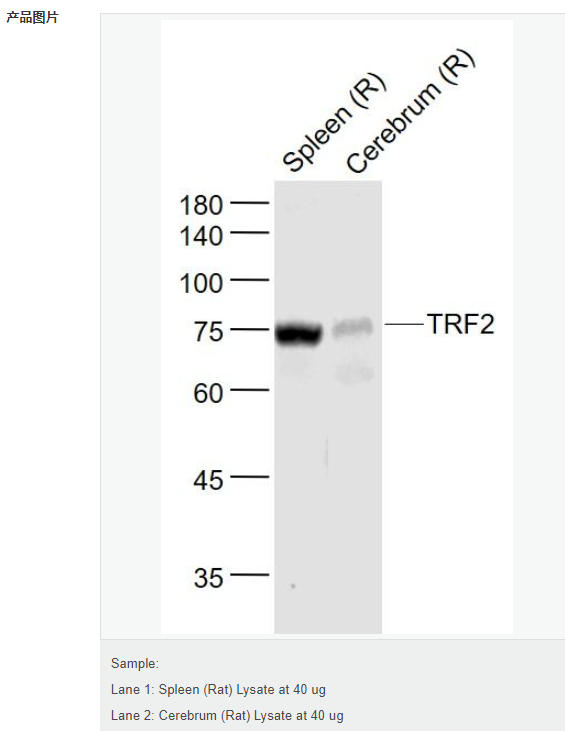

貨號(hào)
產(chǎn)品規(guī)格
售價(jià)
備注
BN40736R-100ul
100ul
¥2360.00
交叉反應(yīng):Rat(predicted:Mouse) 推薦應(yīng)用:WB
BN40736R-200ul
200ul
¥3490.00
交叉反應(yīng):Rat(predicted:Mouse) 推薦應(yīng)用:WB
產(chǎn)品描述
| 英文名稱(chēng) | TRF2 |
| 中文名稱(chēng) | 端粒結(jié)合蛋白2抗體 |
| 別 名 | Telomeric DNA binding protein; Telomeric repeat binding factor 2; Telomeric repeat binding protein 2; TERF 2; TERF2; TRBF 2; TRBF2; TRF 2; TTAGGG repeat binding factor 2. |
| 研究領(lǐng)域 | 腫瘤 轉(zhuǎn)錄調(diào)節(jié)因子 表觀遺傳學(xué) |
| 抗體來(lái)源 | Rabbit |
| 克隆類(lèi)型 | Polyclonal |
| 交叉反應(yīng) | Rat, (predicted: Mouse, ) |
| 產(chǎn)品應(yīng)用 | WB=1:500-2000 not yet tested in other applications. optimal dilutions/concentrations should be determined by the end user. |
| 分 子 量 | 55kDa |
| 細(xì)胞定位 | 細(xì)胞核 |
| 性 狀 | Liquid |
| 濃 度 | 1mg/ml |
| 免 疫 原 | KLH conjugated synthetic peptide derived from mouse TRF2:401-495/495 |
| 亞 型 | IgG |
| 純化方法 | affinity purified by Protein A |
| 儲(chǔ) 存 液 | 0.01M TBS(pH7.4) with 1% BSA, 0.03% Proclin300 and 50% Glycerol. |
| 保存條件 | Shipped at 4℃. Store at -20 °C for one year. Avoid repeated freeze/thaw cycles. |
| PubMed | PubMed |
| 產(chǎn)品介紹 | This gene encodes a telomere specific protein, TERF2, which is a component of the telomere nucleoprotein complex. This protein is present at telomeres in metaphase of the cell cycle, is a second negative regulator of telomere length and plays a key role in the protective activity of telomeres. While having similar telomere binding activity and domain organization, TERF2 differs from TERF1 in that its N terminus is basic rather than acidic. [provided by RefSeq, Jul 2008] Function: Binds the telomeric double-stranded 5'-TTAGGG-3' repeat and plays a central role in telomere maintenance and protection against end-to-end fusion of chromosomes. In addition to its telomeric DNA-binding role, required to recruit a number of factors and enzymes required for telomere protection, including the shelterin complex, TERF2IP/RAP1 and DCLRE1B/Apollo. Component of the shelterin complex (telosome) that is involved in the regulation of telomere length and protection. Shelterin associates with arrays of double-stranded 5'-TTAGGG-3' repeats added by telomerase and protects chromosome ends; without its protective activity, telomeres are no longer hidden from the DNA damage surveillance and chromosome ends are inappropriately processed by DNA repair pathways. Together with DCLRE1B/Apollo, plays a key role in telomeric loop (T loop) formation by generating 3' single-stranded overhang at the leading end telomeres: T loops have been proposed to protect chromosome ends from degradation and repair. Required both to recruit DCLRE1B/Apollo to telomeres and activate the exonuclease activity of DCLRE1B/Apollo. Preferentially binds to positive supercoiled DNA. Together with DCLRE1B/Apollo, required to control the amount of DNA topoisomerase (TOP1, TOP2A and TOP2B) needed for telomere replication during fork passage and prevent aberrant telomere topology. Recruits TERF2IP/RAP1 to telomeres, thereby participating in to repressing homology-directed repair (HDR), which can affect telomere length. Subcellular Location: Nucleus. Chromosome, telomere. Colocalizes with telomeric DNA in interphase cells and is located at chromosome ends during metaphase. Tissue Specificity: Ubiquitous. Highly expressed in spleen, thymus, prostate, uterus, testis, small intestine, colon and peripheral blood leukocytes. Post-translational modifications : Phosphorylated upon DNA damage, probably by ATM or ATR. Similarity: Contains 1 HTH myb-type DNA-binding domain. SWISS: Q15554 Gene ID: 21750 Database links: Entrez Gene: 7014 Human Entrez Gene: 21750 Mouse Omim: 602027 Human SwissProt: Q15554 Human SwissProt: O35144 Mouse Unigene: 63335 Human Unigene: 6402 Mouse Unigene: 35087 Rat Important Note: This product as supplied is intended for research use only, not for use in human, therapeutic or diagnostic applications. |
